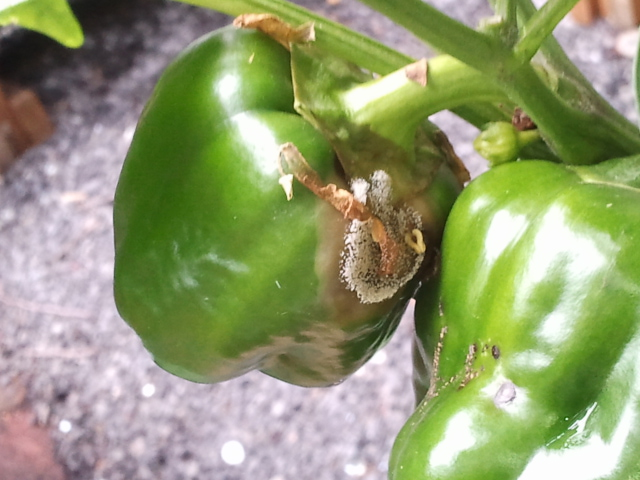QuestionQUESTION: Hello,
I have recently started growing some vegetables and herbs in my backyard. My green peppers have begun to start growing (which is really exciting), but some of the peppers have some soft brown spots near the stem of the pepper. The spots are on the pepper, but at the stem end. I thought it might be blossom end rot, but they are not showing at the bottoms of the peppers. Can blossom end rot occur at other spots than the bottoms? Do you know what might be the problem? They are located outside, and I live in Portland, Oregon so it rains often. Thank you!
ANSWER: Matt:
It is possible, however it is somewhat unlikely. Can you send me a closeup photo of this area on a representative fruit?
Do you water your peppers from overhead? What % of the fruit are affected. What chemicals, if any have you sprayed on these plants? How do the leaves look?
Regards
Steve
---------- FOLLOW-UP ----------
 Green Pepper with bad
Green Pepper with bad
QUESTION: I have attached a photo of what the affected area looks like. It appears to have turned whitish.
I do water the peppers from overhead. Only about 5-10% of the pepper is affected. We have not used any chemicals on the plants. The leaves look healthy and strong.
AnswerMatt:
Based on your picture and description, this does look like a bona fide infectious disease called late blight. This disease is caused by a fungus-loke organism called Phytophthora and can affect tomatoes also. It is favored by wet conditions (wet/poorly drained soils) frequent rainfall or overhead water. Using "Google Images" take a look at some photos to see if they look like a match to your plants. Not many chemicals out there to use for the home gardener, so sanitation is important.
Go ahead and remove/destroy all of the affected fruit (bag it up and dispose of away from your garden area. Reduce overhead water to nothing ,if possible. Try to water the soil rather than getting the plants wet and avoid water splashing from the soil to the fruit (mulch is good for that purpose). This fungus can live and survive in the soil. Well drained soils are very important in disease management. Remove the fruit before you water next time. If you have to water overhead, do it early in the morning so the plants will dry off by lunchtime. When you finish w/ your crop at the end of the season, remove and destroy all of the spent plants (roots too)- do not leave them in the garden area. Burn them if allowed in your community. Burning is a great way to destroy any diseased plant material.
There is a lot of information on the web about this disease. Just "Google "Late Blight of Pepper" and you can read a lot of material. Next year, be sure to rotate yr veggies- don't plant peppers and tomatoes in the same spot you had them in this year.
Regards
Steve






